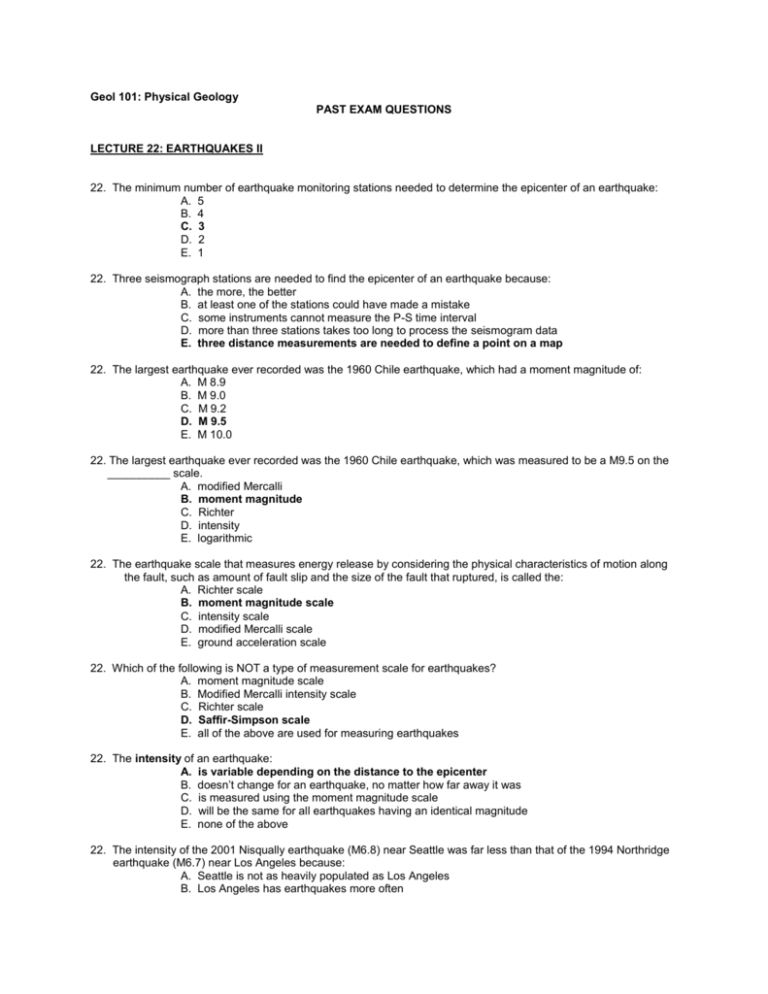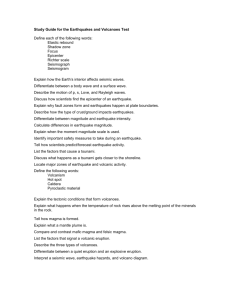Word
advertisement

Geol 101: Physical Geology PAST EXAM QUESTIONS LECTURE 22: EARTHQUAKES II 22. The minimum number of earthquake monitoring stations needed to determine the epicenter of an earthquake: A. 5 B. 4 C. 3 D. 2 E. 1 22. Three seismograph stations are needed to find the epicenter of an earthquake because: A. the more, the better B. at least one of the stations could have made a mistake C. some instruments cannot measure the P-S time interval D. more than three stations takes too long to process the seismogram data E. three distance measurements are needed to define a point on a map 22. The largest earthquake ever recorded was the 1960 Chile earthquake, which had a moment magnitude of: A. M 8.9 B. M 9.0 C. M 9.2 D. M 9.5 E. M 10.0 22. The largest earthquake ever recorded was the 1960 Chile earthquake, which was measured to be a M9.5 on the __________ scale. A. modified Mercalli B. moment magnitude C. Richter D. intensity E. logarithmic 22. The earthquake scale that measures energy release by considering the physical characteristics of motion along the fault, such as amount of fault slip and the size of the fault that ruptured, is called the: A. Richter scale B. moment magnitude scale C. intensity scale D. modified Mercalli scale E. ground acceleration scale 22. Which of the following is NOT a type of measurement scale for earthquakes? A. moment magnitude scale B. Modified Mercalli intensity scale C. Richter scale D. Saffir-Simpson scale E. all of the above are used for measuring earthquakes 22. The intensity of an earthquake: A. is variable depending on the distance to the epicenter B. doesn’t change for an earthquake, no matter how far away it was C. is measured using the moment magnitude scale D. will be the same for all earthquakes having an identical magnitude E. none of the above 22. The intensity of the 2001 Nisqually earthquake (M6.8) near Seattle was far less than that of the 1994 Northridge earthquake (M6.7) near Los Angeles because: A. Seattle is not as heavily populated as Los Angeles B. Los Angeles has earthquakes more often C. buildings in Seattle are designed better than those in Los Angeles D. the Nisqually earthquake was much deeper than the Northridge earthquake E. Seattle is closer to the water, which absorbed a lot of the seismic waves 22. Loose, unconsolidated sediments are not good for buildings because: A. ground shaking is greater in these sediments B. seismic wave amplitudes increase in loose sediments C. liquefaction of the sediments is likely if they are saturated with water D. all of the above E. it’s best to build buildings on unconsolidated sediment, so none of the above 22. Which of the following is an accurate description of liquefaction due to an earthquake? A. when ground shaking causes water-saturated sediment to act like quicksand B. when a shift of the ocean bottom produces a giant wave at the surface C. when earthquakes cause waterlogged mountain slopes to produce landslides D. when seismic waves get amplified in loose sediments, causing more shaking E. when an earthquake causes bodies of water to slosh back and forth 22. What type of earthquake-induced hazard was responsible for the destruction of Yungay, Peru, in 1970? A. tsunami B. ground shaking C. aftershocks D. liquefaction E. landslide 22. Which of the following is an accurate definition of the term tsunami? A. it is a type of earthquake that occurs under the ocean B. it is a type of seismic wave that causes a lot of damage to tall buildings C. it is a water wave generated in the ocean as a result of an earthquake D. it is a type of landslide triggered in a mountainous region during an earthquake E. it is an ancient Japanese method of studying earthquakes 22. Which of the following seismic hazards would not be associated with earthquakes that occur in the New Madrid seismic zone in Missouri? A. ground shaking B. liquefaction C. fire D. ground fractures E. tsunamis









